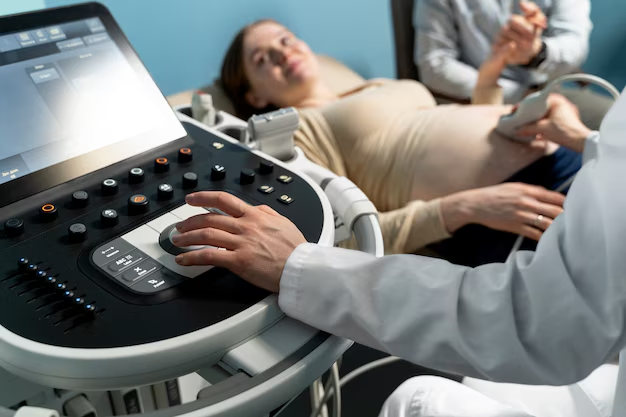
Market Overview
The global point-of-care ultrasound (POCUS) devices market is poised for steady expansion, with growth projected at a CAGR of around 7% over the forecast period. This momentum is driven by several healthcare trends reshaping diagnostic practices worldwide.
Key Request a free sample copy or view report summary: https://meditechinsights.com/point-of-care-ultrasound-devices-market/request-sample/
The rising prevalence of both chronic and acute diseases, a rapidly growing elderly population, and the escalating need for portable, real-time diagnostic capabilities are key factors contributing to market growth. Clinicians today require tools that are fast, accurate, mobile, and accessible, especially in high-pressure environments such as emergency rooms, intensive care units, ambulances, and surgical departments. As healthcare systems shift toward early diagnosis, value-based care, and decentralised imaging, the use of point-of-care ultrasound devices continues to rise. Despite this growth trajectory, the market faces a set of challenges that hinder widespread adoption. High device costs, regulatory burdens, reimbursement gaps, and shortages of trained professionals remain significant barriers. These obstacles create uneven access across regions, especially in low-resource settings, where mobile imaging has the potential to make the most impact. Nonetheless, technological advancements and expanding clinical applications continue to strengthen the role of POCUS as a critical imaging tool in modern medical practice.
Report Overview
Point-of-care ultrasound devices have transformed the way healthcare providers diagnose and manage patients at the bedside. POCUS refers to compact, portable ultrasound systems designed for real-time clinical assessment, enabling clinicians to visualize internal structures rapidly without requiring patients to move to dedicated imaging rooms. These devices are widely used in emergency medicine, critical care, anesthesiology, primary care, musculoskeletal practice, and more. Whether used for detecting internal injuries, assessing cardiac activity, guiding procedures, or managing chronic illnesses, POCUS empowers clinicians to make informed decisions instantly. The value of POCUS extends beyond diagnostics. It enhances procedural safety by providing direct visualization during interventions such as vascular access, nerve blocks, thoracentesis, paracentesis, and airway management. Its portability ensures that medical teams can deliver efficient, personalized care in remote, resource-limited, or fast-paced clinical environments. The adoption of POCUS has grown worldwide due to improvements in image quality, miniaturization, wireless interface, and AI-assisted interpretation. These advancements have made the technology more intuitive, user-friendly, and suitable for a broad spectrum of healthcare professionals.
Rising Demand for Portable and Bedside Imaging in Emergency Settings
The demand for POCUS is particularly strong in emergency and critical care settings, where rapid imaging can significantly influence clinical outcomes. In environments such as ERs, trauma centers, ICUs, and ambulances, POCUS is indispensable due to its ability to deliver immediate insights into life-threatening conditions.
Trauma: The FAST exam helps detect internal bleeding quickly, facilitating prompt surgical intervention.
Lung Ultrasound: Essential for diagnosing pneumonia, pleural effusion, pneumothorax, and pulmonary edema at the bedside.
Undifferentiated Shock: Helps distinguish between hypovolemic, obstructive, cardiogenic, and distributive shock types.
Cardiac Arrest: Enables rapid cardiac activity assessment and helps differentiate true PEA from pseudo-PEA, supporting better resuscitation decisions.
Procedural Guidance: Improves the safety and accuracy of vascular access, airway support, nerve blocks, and fluid drainage procedures.
The heightened need for faster, safer, and radiation-free diagnostic tools continues to accelerate POCUS adoption in time-sensitive care settings.
Advancements in Ultrasound Technologies Fuel Market Growth
Continuous innovation in ultrasound technology is one of the strongest catalysts propelling the POCUS market forward. Manufacturers are developing smarter, smaller, and more connected devices that enhance clinician performance and diagnostic precision.
Artificial Intelligence (AI): AI-enhanced ultrasound systems now automate image optimization, guide scanning techniques, and provide real-time measurements. These advancements reduce operator dependency and support clinicians with limited ultrasound training.
Miniaturization and Portability: Modern handheld and wireless ultrasound probes allow imaging anywhere—home visits, ambulances, rural clinics, war zones, and telemedicine hubs. Their portability significantly broadens clinical accessibility.
Wireless Connectivity: Cable-free ultrasound probes that connect to smartphones and tablets streamline mobility and improve infection control in sensitive environments like ICUs.
Tele-remote Ultrasound and 5G: Remote experts can guide live scanning, interpret images, and support difficult procedures from thousands of kilometres away. 5G networks enable smooth, high-resolution, real-time imaging for remote consultations and robotic ultrasound systems.
These innovations strengthen clinical confidence in ultrasound and promote adoption among a wider range of healthcare practitioners.
Competitive Landscape Analysis
The point-of-care ultrasound market is characterized by strong competition, with established medical imaging giants and emerging innovators striving for technological superiority. Companies focus on advanced product launches, AI integration, strategic collaborations, training initiatives, and investments to strengthen their market footprint. The presence of digital-first ultrasound brands has intensified competition, pushing traditional manufacturers to enhance connectivity, portability, and ease of use in their product lines.
Market Drivers
Rising prevalence of chronic and acute diseases
Growing aging population
Increased demand for portable and bedside imaging
Technological advancement in ultrasound technology
Rising demand for non-invasive diagnostics tools
Attractive Opportunities
Expanding applications in multiple medical specialties
Growing adoption of telemedicine & remote healthcare
Increasing demand in emerging markets
Growing AI and machine learning integration
Key Players
• GE Healthcare
• Koninklijke Philips
• Siemens Healthineers
• Canon Medical Systems Corporation
• Esaote SpA
• Fujifilm Holdings Corp.
• Mindray
• Samsung Electronics Co. Ltd.
• BenQ Medical Technology
• Butterfly Network, Inc.
Get Free Sample Report: https://meditechinsights.com/point-of-care-ultrasound-devices-market/request-sample/
About Medi-Tech Insights
Medi-Tech Insights is a healthcare-focused business research & insights firm. Our clients include Fortune 500 companies, blue-chip investors & hyper-growth start-ups. We have completed 100+ projects in Digital Health, Healthcare IT, Medical Technology, Medical Devices & Pharma Services in the areas of market assessments, due diligence, competitive intelligence, market sizing and forecasting, pricing analysis & go-to-market strategy. Our methodology includes rigorous secondary research combined with deep-dive interviews with industry-leading CXO, VPs, and key demand/supply side decision-makers.